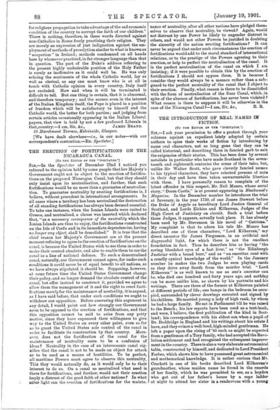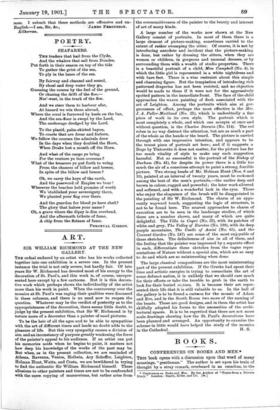THE INTRODUCTION OF REAL NAMES IN FICTION.
[TO THE EDITOR OP THE "SPECTATOR.") SIR,—I ask your permission to offer a protest through your columns against an expedient lately adopted by certain authors to spice their works of fiction by introducing by name real characters, not so long gone that they can be called historical, and describing them in fancied garb to suit the exigencies of their stories. This has been done by several novelists in particular who have made Scotland in the seven- teenth and eighteenth centuries the scene of their tales, but, unlike Sir Walter Scott, who gave cleverly fancied names to his typical characters, they have selected persons of note in their day and have then taken unwarrantable liberties with them. I have personally reason to complain of the latest offender in this respect, Mr. Neil Munro, whose serial story, "Doom Castle," is at present appearing in Blackwood's Magazine. In the December number he introduces the trial at Inverary, in the year 1750, of one James Stewart before the Duke of Argyle as hereditary Lord Justice General of Scotland, and Lords Elchies and Kilkerran, Judges of-the High Court of Justiciary on circuit. Such a trial before those Judges, it appears, actually took place. It has already been used by Mr. Stevenson in his novel of " Catriona." My complaint is that to adorn his tale Mr. Munro has described one of these characters, "Lord Kilkerran," my direct ancestor Sir James Fergusson, in an artificial and disgraceful light, for which there is not the smallest foundation in fact. Thus he describes him as having "the roving bloodshot eyes of a fast liver," as "the Edinburgh Justiciar with a broad burr," and as "an emeritus roue with a cruelly cynical knowledge of the world." In the January number lie makes the two Judges be seen playing cards as they drive away South from the murder trial. "Lord Kilkerran" is as well known to me as one's ancestor can be, who died one hundred and forty years ago, and nothing can be more unlike him, as shown by his portraits and his writings. There are three of the former at Kilkerran painted at different periods of life ; one hangs in the bedroom he occu- pied, surrounded by clever drawings executed and signed by his children. He married young a lady of high rank, by whom he had a large family. He sat in Parliament till he was raised to the Bench ; his law reports have been used as a text-book, and were, I believe, the first publication of the kind in Scot- land ; his correspondence with his eldest son when a pupil of Dr. Doddridge in England and his writings about his estate I have, and they evince a well-bred, high-minded gentleman. He left a paper upon the rising of '45 such as might be expected from a gentleman of a Tory family, who had accepted the Revo- lution settlement and had recognised the subsequent improve- ment in the country. There is also a very elaborate astronomical table, constructed by himself, and dedicated to Lord President Forbes, which shows him to have possessed great astronomical and mathematical knowledge. It is rather curious that Mr. Crockett in one of his books described Lord Kilkerran's grandmother, whose maiden name he found in the records of her family, which he was permitted to see, as a hoyden who got out of her father's house by a rope ladder at night to attend her sister in a rendezvous with a young
man. I submit that these methods are offensive and un-







































 Previous page
Previous page